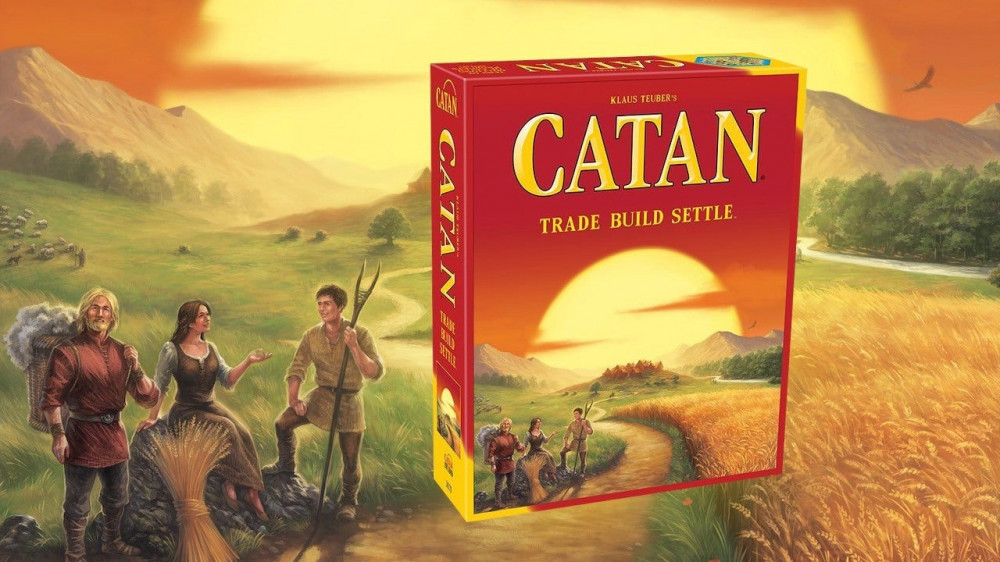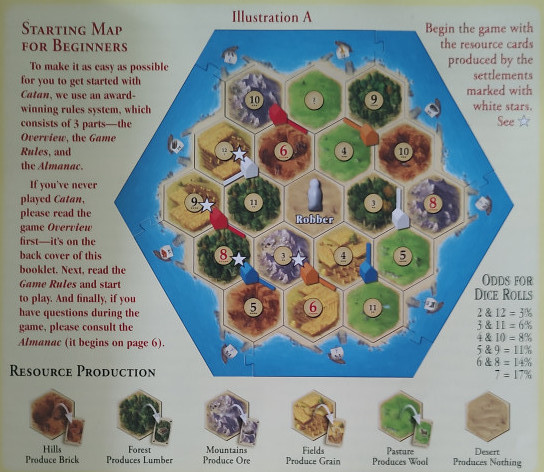 Hey there! Brian here.
Hey there! Brian here.
I’m here today to teach you how to play Catan (Formerly Settlers of Catan.) This is a very simple game that you can pick up in about 20-30 minutes while playing your first game.
But, first, a little background. Catan is a rather popular board game. It was developed in 1995, and since then, it has garnered a large following of all ages. There are still many who have yet to play this game, or some who haven’t played it in a while. This guide is here to help with setting up your first game of Catan and teach you how to play it. This guide is also useful as a refresher if you haven’t played a game in a while.
Board Set-Up

The board in Catan is modular and customizable, meaning there’s many ways you can set it up. With the expansions, it gets even more modular. For your first game, it is highly recommended you set up your board in the way it is recommended in the rulebook. This allows for a balanced game with decent resource diversity. An example of this is given right here. With future games, where you gain a handle on the game, you can set up the board in any way you want, or you can randomize the game board entirely. If you wish to set your own settlements, I will cover this later in this post. Note: If you are playing with three players the red settlements will not be placed. Each player will put any remaining settlements, cities, roads, and their reminder cards in front of them. The development cards (white back) are set to the side. The resource cards (blue back with the continent) are sorted by type and set to the side. The resources are also listed on the example given right here. The special “Longest Road” and “Largest Army” tiles get set to the side as well. Lastly, each player will gain resource cards with resources next to their settlement with a white star.
Gameplay
Start of turn
Playing Catan goes by turns. According to the rules, the oldest player goes first, although you can roll the two dice to decide who goes first. Turn order is decided clockwise after the first player. Each player on their turn rolls the two dice to get a total. Each player who has a settlement next to a tile with the number rolled gains a resource of that tile. For example, if a six is rolled in our example above, the red and white players would gain a brick, and the orange player would gain a grain. If a seven is rolled, instead the robber is moved. When this happens, first every player who has more than eight resources discards half of their resources. Then the active player (player who’s turn it is) moves the robber onto a tile. This renders that tile unable to produce resources. Finally, the active player takes a random resource from a player who has a settlement next to the tile the robber was placed on.
Trading
After the roll is completed, players may now trade and build. It is recommended for new players to trade for the resources they need first before they build. The active player can trade with any of the other players if a mutual agreement is arranged. A player may not trade development cards, nor may they not give a resource away (this includes trading two sheep for one sheep.) Two players who’s turn it is not may not trade amongst themselves either. The player can also initially trade resources with the bank (resource cards set to the side) at a four-to-one rate. This rate can be improved upon if a player settles upon a port on the edge of the board. These ports can either improve the flat rate to a three-to-one rate, or allow a player to trade two of a specific resource for any resource. A player cannot trade with the bank if it is not their turn.
Building
Once trading is completed, players may build. Players reminder cards do tell you exactly what you can build. Players may build a road for one lumber and one brick. Roads are placed on the sides of two tiles. Roads are useful to allow you access to more places. If a player has an unbroken road of five pieces, they gain the longest road tile. Another player may take the longest road if they overtake the player that has the longest road. Players may not place a road on a side that already has a road constructed
They can also build a settlement on an intersection for one lumber, one brick, one sheep, and one grain. The “distance rule” states a settlement can only be placed if all three available intersections adjacent to it are unoccupied by settlements or cities (this includes the player who is placing it.) A settlement also must be attached to one of that player’s roads. Once a settlement is placed, it will start producing resources like the starting settlements. If a settlement is on the same tile as a starting settlement, when that result is rolled, it will produce one resource for each settlement.
The next thing you can build is a city for three ore and two wheat. A city replaces a settlement, and doubles the resource output of that settlement. For example, if orange upgrades their south-most settlement to a city in our example, when a six or a four is rolled it will produce two grain, and when a three is rolled it will produce two ore. Note: if in the rare case a player runs out of a building to build that player can no longer build that building.
The last thing the player can build is a development card for one grain, one sheep, and one ore. In doing so, they draw a development card from the deck (white back) and keep it face down until they are ready to play it. The player usually cannot play a development card the same turn they draw it. Development cards can be played any time during a player’s turn and grants benefits. One of the noteworthy cards is a Knight card. It allows a player to move the robber and steal from a player. This differs from rolling a seven, as the players with eight or more resources in hand will not be discarding half of their resources. If a player has played three Knight cards, they get the Largest Army, which acts similarly to the Longest Road. The other highly noteworthy cards are the victory point cards, which grants a victory point.
Scoring
Scoring is granted by victory points. A settlement is worth one victory point, while a city is worth two victory points. Both the Largest Army and Longest Road are worth two victory points. Lastly, any victory point development cards are worth one victory point. The first player to ten victory points immediately wins the game on their turn. If in the rare case a player gets ten victory points on an opponent’s turn, gameplay resumes until a player has ten victory points on their turn.
Conclusion
Catan is an excellent game. It is beautifully simple, and after this article you should be able to play the game. There are some more complex rulings on specific situations, but those are covered in the Almanac that comes with the rulebook. If you would like to see my in-depth review of Catan, you can find it here.
Anyway, that’s the rules of how to play this game. If you have any questions, feel free to leave a comment and I’ll get back to you.